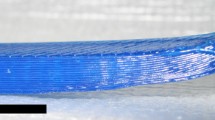Abstract
This work describes a new filament deposition in fused deposition modeling process through criterion based on mechanical stress. This criterion requires that the filaments’ directions to follow the principal directions of the stress in the sample. The article also presents several Crack-test specimens that have been printed with and without respect to this criterion. The fracture behavior of these specimens has been investigated. The results show that criterion leads to an improvement of 30% in the fracture toughness. Digital image correlation has been extensively used to study the local strain field in the specimens. The strain cartographies reveal a drastic change in fracture behavior. The modification of filament direction leads to “ductile-like behavior” in crack extension which is characterized by a large deformation zone associated with a slow crack growth rate during the crack propagation.











Similar content being viewed by others
Notes
The high displacement gradient between the crack lips leads to irrelevant high strain if the crack located subsets are not removed.
References
Abramovitch H, Burgard M, Edery-Azulay L, Evans KE, Hoffmeister M, Miller W, Scarpa F, Smith CW, Tee KF (2010) Smart tetrachiral and hexachiral honeycomb: sensing and impact detection. Compos Sci Technol 70(7):1072–1079 Special issue on Chiral Smart Honeycombs
Ahn SH, Montero M, Odell D, Roundy S, Wright Paul K (2002) Anisotropic material properties of fused deposition modeling abs. Rapid Prototyp J 8(4):248–257
Anderson TL (2005) Fracture mechanics fundamentals and applications. Taylor & Francis, London
Beaman JJ, Barlow JW, Bourell DL, Crawford RH, Marcus Harris L, McAlea Kevin P (1997) Solid freeform fabrication: a new direction in manufacturing, vol 2061. Kluwer Academic Publishers, Norwell, pp 25–49
Bellini A, Güçeri S (2003) Mechanical characterization of parts fabricated using fused deposition modeling. Rapid Prototyp J 9(4):252–264
Blaber J, Adair B, Antoniou A (2015) Ncorr: open-source 2d digital image correlation matlab software. Exp Mech 55(6):1105–1122
Committee E08 (2001) Standard test method for measurment of fracture toughness. In: Annual Book of ASTM standard, 03.01(E1820-01)
Crump SS (1992) Apparatus and method for creating three-dimensional objects. US Patent 5,121,329
Crump SS (1994) Modeling apparatus for three-dimensional objects. US Patent 5,340,433
Galantucci LM, Lavecchia F, Percoco G (2008) Study of compression properties of topologically optimized fdm made structured parts. CIRP Ann-Manuf Technol 57(1):243–246
Gardan J (2016) Additive manufacturing technologies: state of the art and trends. Int J Prod Res 54(10):3118–3132
Gardan N, Schneider A, Gardan J (2016) Material and process characterization for coupling topological optimization to additive manufacturing. Comput-Aided Des Appl 13(Supplement C):1–11
Harilal R, Ramji M (2014) Adaptation of open source 2d dic software ncorr for solid mechanics applications. In: 9th International symposium on advanced science and technology in experimental mechanics
Lee BH, Abdullah J, Khan ZA (2005) Optimization of rapid prototyping parameters for production of flexible abs object. J Mater Process Technol 169(1):54–61
Malone E, Lipson H (2007) Fab@ home: the personal desktop fabricator kit. Rapid Prototyp J 13(4):245–255
Miller W, Smith CW, Scarpa F, Evans KE (2010) Flatwise buckling optimization of hexachiral and tetrachiral honeycombs. Compos Sci Technol 70(7):1049–1056
Montero M, Roundy S, Odell D, Ahn SH, Wright PK (2001) Material characterization of fused deposition modelling (FDM) ABS by designed experiments. In: Rapid prototyping and manufacturing conference, Society of Manufacturing Engineers (SME), Cincinnati, OH, 15–17 May 2001
Pan B, Xie H, Guo Z, Hua T (2007) Full-field strain measurement using a two-dimensional savitzky-golay digital differentiator in digital image correlation. Opt Eng 46(3):033601–033601
Prall D, Lakes RS (1997) Properties of a chiral honeycomb with a poisson’s ratio of1. Int J Mech Sci 39(3):305–314
Rezaie R, Badrossamay M, Ghaie A, Moosavi H (2013) Topology optimization for fused deposition modeling process. Procedia CIRP, 6 Suppl C:521–526. In: Proceedings of the 17th CIRP conference on electro physical and chemical machining (ISEM)
Vesenjak M, Krstulović-Opara L, Ren Z, Domazet Z (2010) Cell shape effect evaluation of polyamide cellular structures. Polymer Test 29(8):991–994
Ziemian C, Sharma M, Ziemian S (2012) Anisotropic mechanical properties of ABS parts fabricated by fused deposition modelling. Mech Eng 23:167–180. https://doi.org/10.5772/34233
Author information
Authors and Affiliations
Corresponding author
Rights and permissions
About this article
Cite this article
Gardan, J., Makke, A. & Recho, N. Improving the fracture toughness of 3D printed thermoplastic polymers by fused deposition modeling. Int J Fract 210, 1–15 (2018). https://doi.org/10.1007/s10704-017-0257-4
Received:
Accepted:
Published:
Issue Date:
DOI: https://doi.org/10.1007/s10704-017-0257-4




